A ‘fast lane’ for electrons
The study of ultra-pure materials still has many ways to surprise and delight! For delafossite metals it was shown that wires sculpted from the same single crystal have very different resistivities depending on the angle at which they are cut. From the fundamental physics point of view, the laws of bulk resistivity are being broken.
One of the most important properties of materials for future electronic technologies is the efficiency with which they allow an electrical current to pass. This property is described by a material-specific quantity called the resistivity. The ‘delafossites’ (named after French crystallographer Gabriel Delafosse) are special materials that can feature extremely low resistivities, as has been proven by extensive research in our Institute. Now, however, they have been shown to be even better than anyone had expected.
The resistivity of any material obeys a set of rules related to the underlying symmetries of its crystal lattice. In the delafossites, the atomic planes in which the electrons flow have the three-fold symmetry of an equilateral triangle. For such a symmetry, the resistivity is expected to be isotropic, in other words the value of resistivity is independent of the crystallographic direction along which it is measured. However, this statement is only true, strictly, for samples which look essentially infinite in all directions on the scale of the distance that the moving electrons can go before scattering, i.e. bouncing off some crystalline imperfection. In the delafossites, this distance, known as the mean free path, can be very long: up to one hundred thousand interatomic spacings, which is about 1000 times longer than in most commonly studied materials.

This is not the only way in which the electrons in the delafossite metals are special. Instead of having a whole range of velocities like those of ordinary metals, they have only six different velocities. As a consequence, in a wire cut to be narrower than the mean free path, there is a big advantage if one of these preferred velocity directions is aligned with the wire. A team of researchers led from our Institute, in collaboration with colleagues from Stanford University, the University of British Columbia and University of Toronto, has shown that wires sculpted from the same single crystal have very different resistivities depending on the angle at which they are cut. From the fundamental physics point of view, the laws of bulk resistivity are being broken because by fabricating narrow device channels, the symmetry is being lowered relative to that of the underlying crystal lattice. In terms of potential applications, the work may also be influential because it shows how to beat the bulk properties of the host material in just the kind of narrow wires that will be used as interconnects in future electronic technologies. The study of ultra-pure materials still has many ways to surprise and delight!











